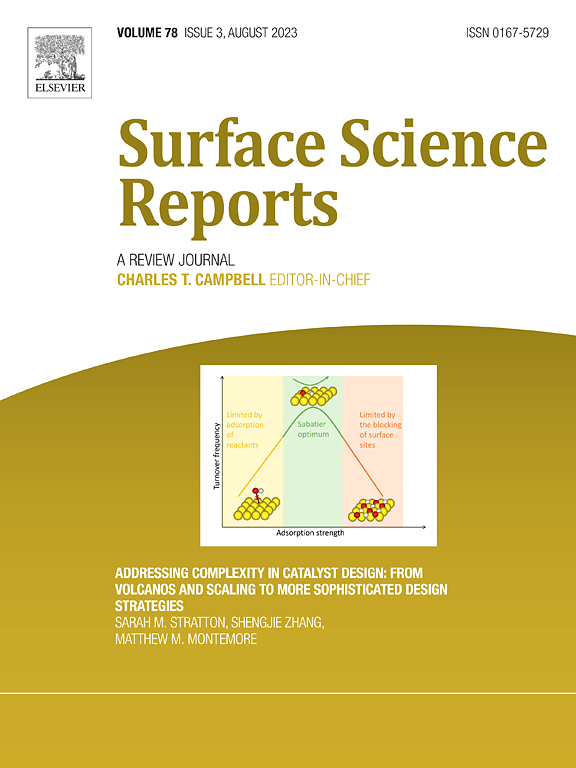地球化学界面的振动光谱
IF 8.7
1区 化学
Q1 CHEMISTRY, PHYSICAL
引用次数: 0
摘要
矿物/水界面在地球化学中无处不在,并被用于从催化到二氧化碳封存的应用。界面形态的微小变化会引起离子迁移率、表面电荷和溶剂取向的巨大变化,从而影响这些地球化学界面的功能。虽然我们探测埋藏界面的能力已经通过表面特异和敏感的振动光谱得到了提高,但表面基团和水的重叠响应使得这些系统的完整结构解释变得困难。我们相信,通过强调最近的实验和计算工作,可以取得进一步的进展。本文回顾了现代光谱和计算技术对SiO2、Al2O3、CaF2和TiO2/水界面附近溶剂和表面结构的演变和目前的认识。通过比较从一系列振动光谱和模拟中收集的信息,可以在以下领域取得进展,包括但不限于;地球化学、工业/石油化学、界面科学、振动光谱学、计算化学和材料科学。本文章由计算机程序翻译,如有差异,请以英文原文为准。
Vibrational spectroscopy of geochemical interfaces
Mineral/aqueous interfaces are ubiquitous in geochemistry and are employed for applications spanning catalysis to CO2 sequestration. Small changes in interface morphology have been shown to induce large changes in ion mobility, surface charge, and solvent orientation, which affect the function of these geochemical interfaces. While our ability to probe buried interfaces has been advanced by surface specific and sensitive vibrational spectroscopies, the overlapping response of surface groups and water has made complete structural interpretations of these systems difficult. We believe that by highlighting recent experimental and computational works further progress can be made.
This review follows the evolution and current understanding of solvent and surface structure near SiO2, Al2O3, CaF2, and TiO2/aqueous interfaces generated by modern spectroscopic and computational techniques. By comparing information gathered from a range of vibrational spectroscopies and simulations progress can be made in the following fields including and not limited to; geochemistry, industrial/petroleum chemistry, interface science, vibrational spectroscopy, computational chemistry, and materials science.
求助全文
通过发布文献求助,成功后即可免费获取论文全文。
去求助
来源期刊

Surface Science Reports
化学-物理:凝聚态物理
CiteScore
15.90
自引率
2.00%
发文量
9
审稿时长
178 days
期刊介绍:
Surface Science Reports is a journal that specializes in invited review papers on experimental and theoretical studies in the physics, chemistry, and pioneering applications of surfaces, interfaces, and nanostructures. The topics covered in the journal aim to contribute to a better understanding of the fundamental phenomena that occur on surfaces and interfaces, as well as the application of this knowledge to the development of materials, processes, and devices. In this journal, the term "surfaces" encompasses all interfaces between solids, liquids, polymers, biomaterials, nanostructures, soft matter, gases, and vacuum. Additionally, the journal includes reviews of experimental techniques and methods used to characterize surfaces and surface processes, such as those based on the interactions of photons, electrons, and ions with surfaces.
 求助内容:
求助内容: 应助结果提醒方式:
应助结果提醒方式:


